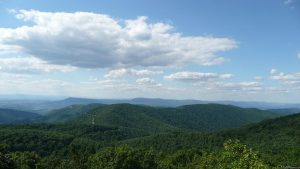
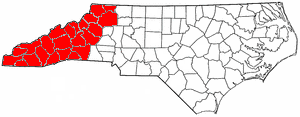
Western North Carolina (WNC) is located in North Carolina’s Mountain Region. This region consists of the Appalachian Mountains and 29 counties. During the last 20 years, Western NC has experienced a different wave of immigrants. Below, we have provided recent demographics of Western North Carolina and a brief history of our immigrants.
Asheville Buncombe County and Henderson County are most populated counties in this region. Asheville Buncombe County has a population of 255,334 residents as of 2018 while Henderson County has a population of 113,758 residents as of 2018.
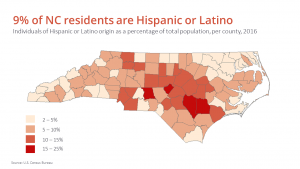
In 2016, the United States Census Bureau reported that between 5-10% of Asheville Buncombe County residents identified as Hispanic or Latino. The same percentage was reported in Henderson County.
The most recent report from the American Community Survey (ACS) reports that Spanish is the second most-spoken language in North Carolina with 658,940 speakers (7.30% of the population).
North Carolina’s socioeconomic growth has been fueled by migration for the past 20 years. There are a plethora of reasons people decide to migrate to North Carolina. However, the main reasons are school, work, and retirement (Tippitt 2014). Through our research, we discovered that the population of immigrants we were investigating were immigrating due to the new work opportunities.
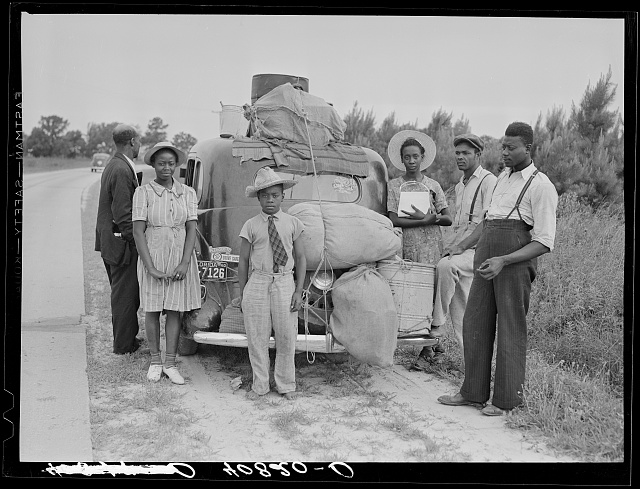
The large flow of migrants to North Carolina commenced in the late 1940s. According to the Encyclopedia of North Carolina, the new farming technology made larger plantations possible. Therefore, more labor was needed to tend the fields. During the 1940s, Latinos moved to North Carolina from Florida. These Latino migrants provided an unprecedented workforce that the state was not prepared for.
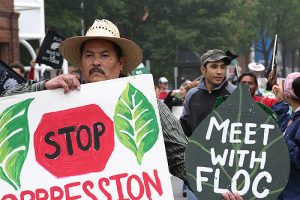
The Latino population was exploited through their work with horrible living conditions, long working hours and low pay. Working conditions did not improve until a report in 1983 by the Legislative Research Commission was given to the North Carolina General Assembly that, “outlined the state’s responsibility for ensuring safe housing and working environments, as well as adequate health insurance, for migrant workers.” (Williams, 2006)
North Carolina’s peak migration was in the year 2000. However, there was a drop in migration from the years 2000-2007 due to the recession (Tippitt, 2014). Migration rates have since remained the same since 2013 (Tippitt, 2014).
Figure 1. Reasons why people move to NC, 2002-2007 v. 2008-2013, CPS
Through the interviews, we learned more about the opportunities our immigrants hoped to find in Western North Carolina. Alejandro and Soledad stated that they have been here for more than 20 years. Soledad explained that previously, only men came to the United States to work when they needed money. The wife and kids would stay in Mexico. However, 20 years ago, things began to change. Whole families began to immigrate to the United States in search of opportunities. “That is when the Hispanic community began to grow here [Western North Carolina].” (Soledad, 2018)
Sources:
“Group of Florida Migrants on Their Way to Cranberry, New Jersey, to Pick Potatoes. Near Shawboro, North Carolina.” NCPedia, Library of Congress, www.ncpedia.org/migrant-workers.
Ilys, Seth, and Gooday.1 at English Wikipedia. Western North Carolina. 25 Jan. 2007, commons.wikimedia.org/wiki/File:Westernnorthcarolina.png.
Luckywhitegirl. Photos from a FLOC (Farm Labor Organzing Committee) Rally at an RJ Reynolds Shareholders’ Meeting in Winston Salem, May 6, 2009. 6 May 2009, www.flickr.com/photos/luckywhitegirl/3523383311/in/photostream/.
MrSparkle17. Appalachian Mountains. 30 Mar. 2008, en.wikipedia.org/wiki/File:Appalachian_Mountains.jpg#file.
“State Demographics Data – NC.” Migrationpolicy.org, Migration Policy Institute, 1 Apr. 2018, www.migrationpolicy.org/data/state-profiles/state/demographics/NC.
Tippett, Rebecca. Reasons Why People Move to NC, 2002-2007 v. 2008-2013, CPS. UNC Carolina Population Center, 28 Jan. 2014, demography.cpc.unc.edu/2014/01/28/why-do-people-move-to-north-carolina/.
Tippitt, Rebecca. “Why Do People Move to North Carolina?” UNC Carolina Demography , 28 Jan. 2014, demography.cpc.unc.edu/2014/01/28/why-do-people-move-to-north-carolina/.
“U.S. Census Bureau QuickFacts: North Carolina.” Census Bureau QuickFacts, United States Census Bureau, 1 July 2017, www.census.gov/quickfacts/NC.
U.S. Census Bureau. Hispanic/Latino Population North Carolina 2016. demography.cpc.unc.edu/wp-content/uploads/2017/10/2016-NC-Hispanic-population-share-by-county.png.
“Western North Carolina.” Wikipedia, Wikimedia Foundation, 27 Apr. 2018, en.wikipedia.org/wiki/Western_North_Carolina.
Williams , Wiley J. “Migrant Workers .” NCpedia, 2006, www.ncpedia.org/migrant-workers.
 (Tippitt 2014)
(Tippitt 2014)